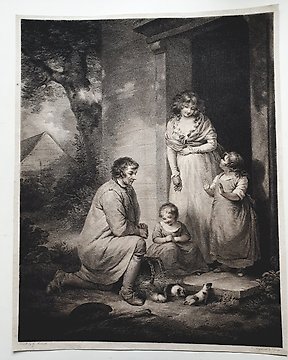
George Morland (1763-1804), after, by Thomas Gaugain (1756-1810?) - Guinea pigs
N. 85070429

N. 85070429

Portrait of King James II brother of Charles II, created Lord High Admiral after the Restoration of the Monarchy in 1660.
After the Restoration, James was confirmed as Lord High Admiral, an office that carried with it the subsidiary appointments of Governor of Portsmouth and Lord Warden of the Cinque Ports.[39] Charles II also made his brother the Governor of the Royal Adventurers into Africa (later shortened to the Royal African Company) in October 1660, an office James retained until after the Glorious Revolution when he was forced to resign. When James commanded the Royal Navy during the Second Anglo-Dutch War (1665–1667) he immediately directed the fleet towards the capture of forts off the African coast that would facilitate English involvement in the slave trade (indeed English attacks on such forts occupied by the Dutch precipitated the war itself).James remained Admiral of the Fleet during the Third Anglo-Dutch War (1672–1674), during which significant fighting also occurred off the African coast. Following the raid on the Medway in 1667, James oversaw the survey and re-fortification of the southern coast.
On 6 May 1682, James narrowly escaped the sinking of HMS Gloucester, in which between 130 and 250 people perished. James argued with the pilot about the navigation of the ship before it ran aground on a sandbank, and then delayed abandoning ship, which may have contributed to the death toll. This maybe the event referred to by the broken anchors at the bottom of the print.
‘His Royal Highness being gone into the Mary Yatcht, ordered all the Yatchts to Anchor, and to send off their Boats, as did likewise the Happy Return (the other three Frigats having lost Company) in the mean time the Glocester still beat on the Sand, her Head being cast aboat to the SW and by W, and the Water encreasing as high as the Gun Deck. However, the lifting of the Sea forced her off of the Sand, and she went into 15 fathom Water before we could let go our Anchor, which proved the loss of many poor Mens Lives. We Anchored and brought her Head up almost to Windward, we stil working with the Pumps and Bailing, but to no purpose; the Water encreasing so fast, that it was three Foot above the Gun-Deck, before we endeavoured to save our selves. She sunk so fast, that before the Boats could take out the Men (although there was great diligence used) the Ship was under Water, and several of our Men perished with her, Sir John Berry hardly escaping by a Rope over the Stern, into Captain Wybourn's Boat.”
— except from The London Gazette, Thursday 11 May to Monday 15 May 1682, No. 1720
The show- was discovered in 2007 28 miles off the English coast of Norfolk.
The inclusion of the papal triple crown at teen rop of the print refers to James’ Catholicism.
The print has been expertly window mounted. It is on laid paper. And the condition is good.
Come fare acquisti su Catawiki
1. Scopri oggetti speciali
2. Fai l’offerta più alta
3. Paga in tutta sicurezza